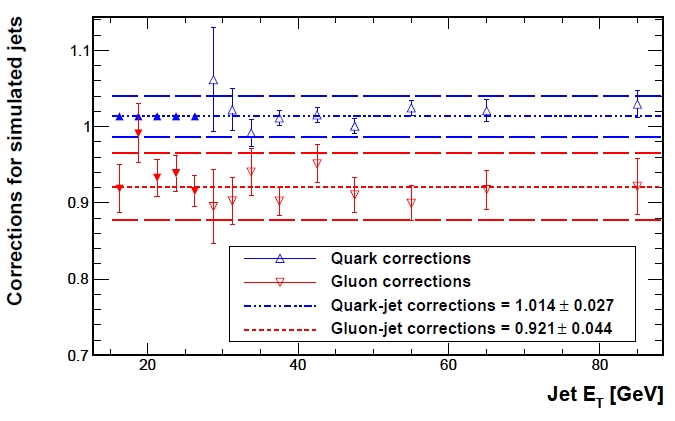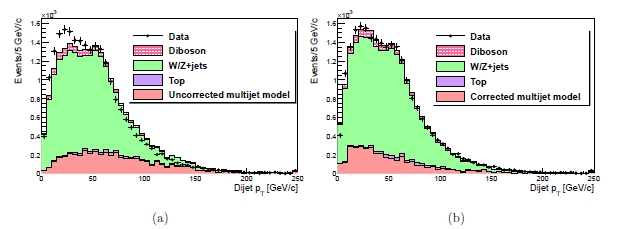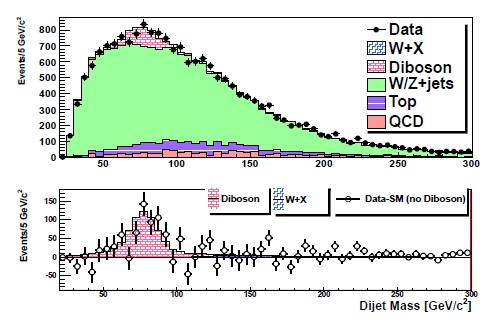After the original publication, an updated result which included more data showed that the anomaly was still there, and its significance had grown larger than four standard deviations. It was clearly a systematic effect: a new particle, or some distortion in the shape of the background. It was thus clear that the significance would have grown to surpass the "five sigma" threshold once the analysis would be repeated unchanged on the full Run 2 data sample.
I am very pleased to observe how the hard work of the collaboration has produced a satisfactory solution of the mystery. Already last year the Ph.D. thesis of Marco Trovato demonstrated that the dijet mass bump could be understood as the combined effect of two independent, subtle causes; but a publication was certainly needed to put the word "end" to the controversy.
Indeed, yesterday finally CDF sent to the Cornell Arxiv their publication based on the full Run 2 data sample of W + jet events, where they dissect the competing effects, size up their impact in the dijet mass distribution, and demonstrate how their careful accounting completely washes out any discrepancy between data and background predictions: no bump exists any more, and the mass spectrum is much better understood now than it used to be.
One of the causes of a distortion in the dijet mass spectrum was the different jet energy scale of quark and gluon jets. Quarks and gluons produce slightly different jets when they hadronize, due to the higher colour charge of the latter; it is well known that gluon jets are broader and contain a larger number of hadrons, but this is a small difference overall, and it would be surprising to know that the energy calibration procedure used to infer the energy of the parton from the observed calorimetric deposits of the hadronic jet should distinguish quark jets from gluon jets. But that is precisely what the paper shows.

In the figure above you can see how there is a different correction factor to be applied to quark and gluon jets if one treats them separately. As gluon jets are overcorrected by the standard calibration procedure, and as they do not populate uniformly the mass range, the lack of accounting of this difference causes a mismodeling of the background distribution.
The other cause of a mismodeling is only present in the electron dataset. W+jets events are divided in "muon plus jets" and "electron plus jets" depending on the flavour of the lepton which tags the w boson decay. The difference between the two subsets is that electrons have a significantly higher chance of being faked by hadronic jets: the electron sample includes a twenty times larger contamination from QCD multijet backgrounds. The latter are processes that do not include a W boson in the final state, but just quarks and gluons. One of the latter produces a spurious electron signal, and another produces a jet whose energy is badly mismeasured in the calorimeter (typically when its leading hadrons slip by a crack between calorimeter modules).
In the original analysis, the multijet background had not been understood at the level of detail of the present publication. The additional care in handling the 10% multijet background improves significantly the agreement of data and predicted background admixture in all kinematical distributions, as exemplified below.
 Above: pt distribution of the two-jet system in data and simulated backgrounds before (labeled "a", left) and after (labeled "b", right) the tuning of the QCD multijet background model.
Above: pt distribution of the two-jet system in data and simulated backgrounds before (labeled "a", left) and after (labeled "b", right) the tuning of the QCD multijet background model.By putting together the improvements to the background modeling, CDF finally reaches a very pleasant understanding of W+jets data. As you can see in the two graphs below, there is a significant distorsion in the spectrum before the improvements (first graph), while after their application there is no discrepancy in the spectrum any more. From the lack of a signal it is thus possible to set a very stringent 95% CL upper limit on the presence of a dijet resonance at 144 GeV.

Above: the dijet mass distribution resulting from a update to the full Run 2 data sample of the original analysis, prior to the improvements. The blue histogram shows the tentative interpretation of the 145 GeV excess as a new W+X process. The bottom panel shows the data once all background processes except WW and W+X are subtracted bin by bin.

Above: the dijet mass distribution after the additional corrections. The lower panel shows that once all backgrounds are subtracted only the pink diboson contribution (WW,WZ) remains. A good agreement is visible throughout the spectrum, without the need to invoke additional processes.
Of course other experiments had already "resolved" the issue after the original CDF publication: both DZERO and the ATLAS and CMS experiments had searched for the tentative resonance, finding none of it. However, the understanding of the CDF data remained unsolved business until now.





Comments